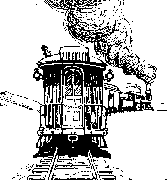 [Go Back to My
Railroad Index]
[Go Back to My
Railroad Index]
I have been constantly impressed with the ability of LGB track to function in the great outdoors. The electrical wiring on my railroad was installed about ten years ago. After cleaning the track, and hooking up all the connections, it performed reliabily, after minimal fine tuning.
However, one thing track wiring lacks is spontaneity. It always grieved me when I had to make up an excuse when one of the neighborhood boys asked to run the trains. They didn't understand that it took at least twenty minutes to get everything up and running, even if everything worked correctly the first time. And troubleshooting is not what they wanted to do. So the excuses kept coming. As did the disappointment of the boys.
Jason was the last straw. He asked me over and over to run the trains. Even when I had a half hour to spare, I had to make up an excuse. I got tired of it. So I headed for Mike's Hobby Shop to see what they had in the nature of battery power.
I have been following the development of battery power in outdoor railroads for several years. I had noticed that the Airwire transmitters had gotten much favorable comment. Gerhardt, at Mike, was a big fan. On May 27th, Maria and I spent a pleasant half hour going over all the pluses and minuses of the system. I spotted a nice LGB Forney steam engine, that I thought would be good for young hands to run. A Phoenix sound board would really add to the fun. But the batteries would have to fit into a trailing car. I didn't like that, but I decided that this setup was for the kids, so, in the immortal words of Richie Brockelman, what the hay.
I told Gerhardt that I would think it over and get back to him by Tuesday. The total package would be over a thousand dollar, so I wanted to research some more. Maria figured it would take me another year of internet surfing to make up my mind, but I fooled her.
On Tuesday, May 30th, I called Gerhardt and gave him the go-ahead. I went with the Forney, and I added a C&S boxcar for the trailing car. I specified Kadee couplers on both the engine and trailing car. And a Phoenix soundboard.
On Friday, June 16, 2006, Gerhardt called with the good news that everything was in. I made a date to pick up the stuff on Saturday. The damage came to slightly over $1300.00.
When we arrived at Mike's on Saturday, Gerhardt was with another customer. I spotted the Forney and the C&S boxcar on the layout they have in the store. I also spotted the instruction manual for the Airwire 900 transmitter. I breezed through it while we waited.
When Gerhardt finished up, he joined us at the store layout, transmitter in hand. He explained how everything worked. Inside the boxcar is an "on-off" switch. Up is labeled "run." Down is for charging the batteries. Next to this toggle is another switch for the volume control on the speaker. This is a momentum switch. Holding it up increases the volume, and holding it down lowers the volume. The speaker was very nice.
Also inside the boxcar are two plugs for the battery chargers. They wired the batteries in parallel, so I have about four hours of run time, according to the battery specs. But I also have to recharge both batteries at the same time. Thus, two chargers are necessary. On the whole, I like this system. Four hours should be more than enough.
The Phoenix sound board is fantastic. In addition to the traditional engine chuffs, it has a signal for bells and other interesting sounds. Pushing button 3 on the transmitter, for example, gives the clanking sound made when two couplers meet. I can't wait to demonstrate that effect.
There are also sounds for taking on water. And coal. And for shoveling the coal. You can actually hear the shovel scraping on the metal of the coal bin. Wow.
The system performed flawlessly at the store. I was ready to test it on my layout.
We had severe rain on the way home. Everything was soaked. I decided not to test the system in the rain. But, an advantage of battery power immediately manifested itself. All I had to do was wait for the rain to stop. Even though the layout was soaked, I could run the Forney so long as the track was dry. Before, I would be leery about hooking up the electricity in a wet environment, even if the rain had stopped. Not so with battery power.
I set the Forney and boxcar on the track, dragged Maria out to watch, turned on the transmitter, and started things up. From the back porch! The Airwire system has great sensativity to slow speeds. You can really make the engine creep. I quickly walked up to the layout and walked around as I powered my engine. It was a totally different experience walking along beside the engine as it did its thing. I am going to love this system!
I know $1300 is a lot of money. I would have saved a considerable amount if I had used one of my existing engines and boxcars. But I wanted Mike's to put together a totally new unit so I could see the best Airwire has to offer. I am well pleased. I can't wait for the next time Jason asks to run the trains. And, after all, that's what it's all about.
Last revised: June 19, 2006